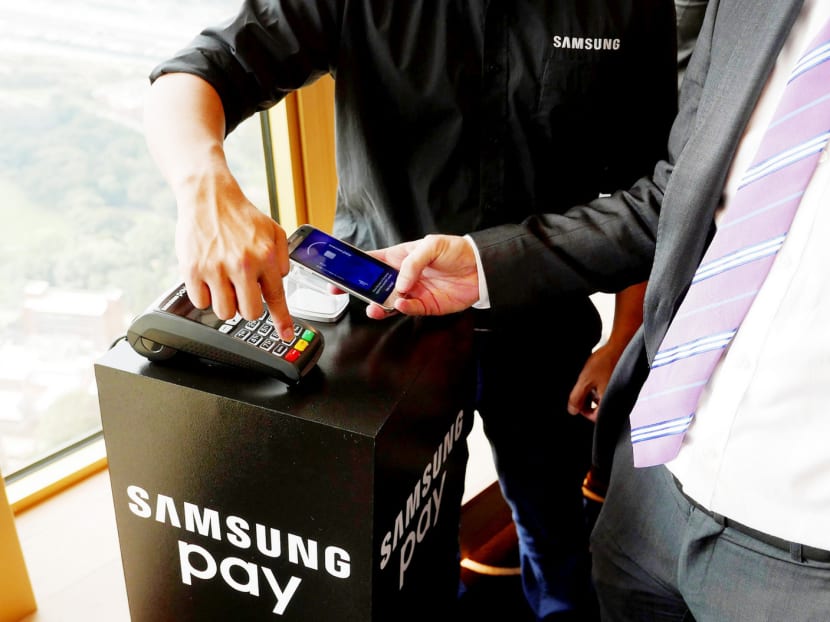Pros, cons of managing money with a mobile wallet
After just having local mobile payment services such as Dash available for a few years, the arrival of Apple Pay, Samsung Pay and Android Pay this year has given consumers new options for mobile wallets that they can use in even more places. It might seem about time to leave the wallet at home and just carry a phone.

MasterCard said that almost half of consumers recently surveyed in Singapore began making purchases with their mobile devices within the past year. Photo: Reuters
After just having local mobile payment services such as Dash available for a few years, the arrival of Apple Pay, Samsung Pay and Android Pay this year has given consumers new options for mobile wallets that they can use in even more places. It might seem about time to leave the wallet at home and just carry a phone.
MOBILE WALLETS
The basic idea behind a mobile wallet is that you can replace the cards and cash in your wallet with your phone. Indeed, mobile wallets can be used to pay for everything, from meals and clothes to movies and travel.
Mobile payments are not new here, with the first services having debuted in the 1990s, and with hundreds of thousands of people having signed up to use PayLah!, Dash or other services in the past several years.
Despite all those launches, however, the MasterCard Mobile Shopping Survey released earlier this year showed that just 23 per cent of respondents here use digital wallets.
The slew of new “Pay” services this year may give mobile wallets a boost.
The Pay wallets allow you to make payments with cards from several banks using a single device. Sign up for Android Pay and load credit cards or debit cards onto it, for example, and you can pay at merchants by tapping your phone on a terminal. Unlock your phone, choose your card, tap and pay, and you will get a digital confirmation that makes spending easy to track.
With multiple cards on your phone, you can choose which one to use to get the best deal. Along with the usual discounts at merchants and cashback or points, using Apple Pay from OCBC Bank may get you 5 per cent cashback and using Android Pay from POSB may give you a 25 per cent rebate on your first several transactions.
Despite how easy using a mobile wallet can be, some consumers are concerned about not being able to pay at terminals that do not accept contactless payments with just a tap. They are also worried about what happens when the phone battery goes flat, as well as security and privacy.
It can also take longer to pull out a phone and get it ready than to pull out a card. Moreover, services available in other countries, such as mobile-only deals or contextual credit, which offers loans instantly while you are making a large purchase, are limited or nonexistent here.
Perhaps more importantly, many consumers do not see digital wallets as solving any big problem yet. “Part of the reason is that the existing payment methods aren’t broken,” wrote Wharton marketing professor David Reibstein.” (The mobile wallet) has got to have some unique and clearly demonstrable advantage before consumers will be flocking to it.”
It is not possible to leave your wallet at home yet, however, as you will still need cash for the hawker centre, your plastic identity card (IC) for many services, your access card for the office, a PAssion Card for discounts, and other cards as well.
That said, there are glimmers of hope. MasterCard said that almost half of consumers recently surveyed here began making purchases with their mobile devices within the past year, and Visa’s 2015 Consumer Payment Attitudes Survey, released in January, showed that half of the online shoppers surveyed here made purchases on a mobile device.
MOBILE BANKING
Other than just using their phone for payments, consumers here can also use mobile banking for far more. Mobile banking is different from a mobile wallet in that it puts a suite of banking services on the phone.
You can check your balances, transfer money, pay bills, get research reports, make investments, set up new accounts and more on your phone. You can also set up a budget and track your spending with services such as OCBC Money In$ights.
Even though having those services available on the phone might seem quite helpful, consumers here also seem to be reluctant to use mobile banking.
Despite consulting firm McKinsey finding as far back as 2014 that 94 per cent of respondents in its Digital Banking in Asia survey accessed their accounts over the Internet, research firm RFi Group found earlier this year that only 24 per cent of bank account holders here conduct transactions on their mobile devices at least once a week, compared with 42 per cent in Indonesia and 34 per cent in India. And although DBS said in March that it has the largest number of mobile banking customers in Singapore, only 1.25 million of its four million customers have actually signed up for mobile banking.
WHAT’S NEXT
While many consumers seem to run much of their non-financial lives on their phones — from making Facebook posts to watching movies and more — mobile wallets do not seem nearly as popular yet.
Mobile wallets are clearly improving, however, and they are likely to get even better before long. Even though you cannot leave your current wallet at home yet, trying out one of the Pay services and getting more cashback or other benefits could be a real advantage while you are waiting for something better to arrive.





